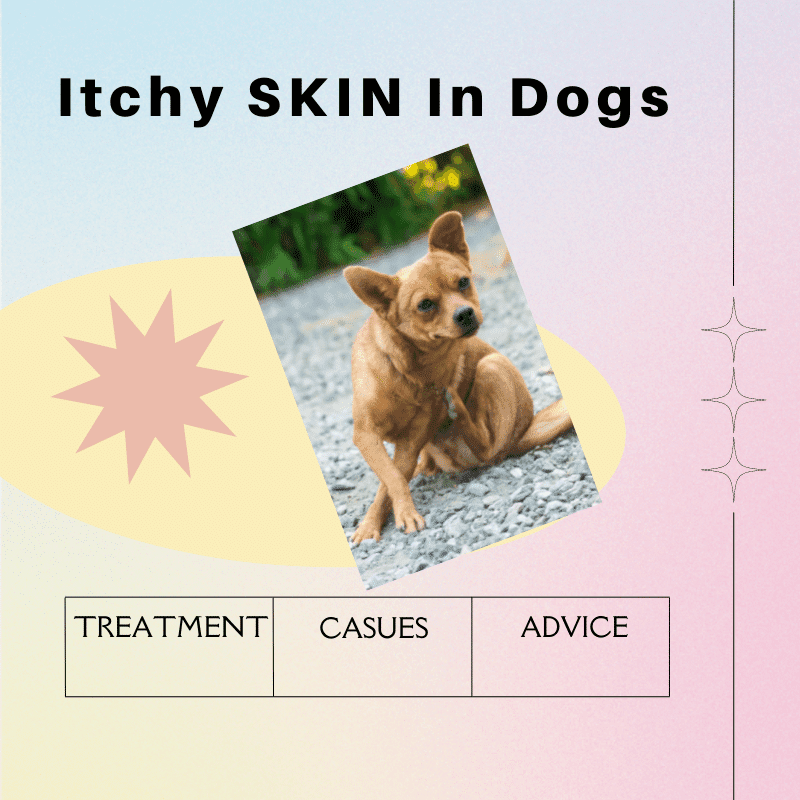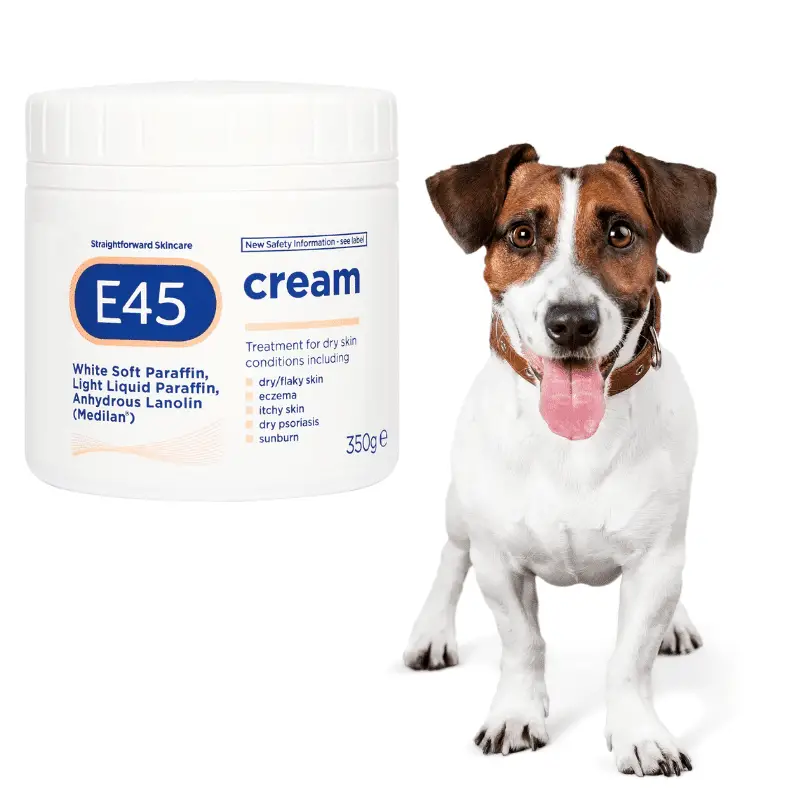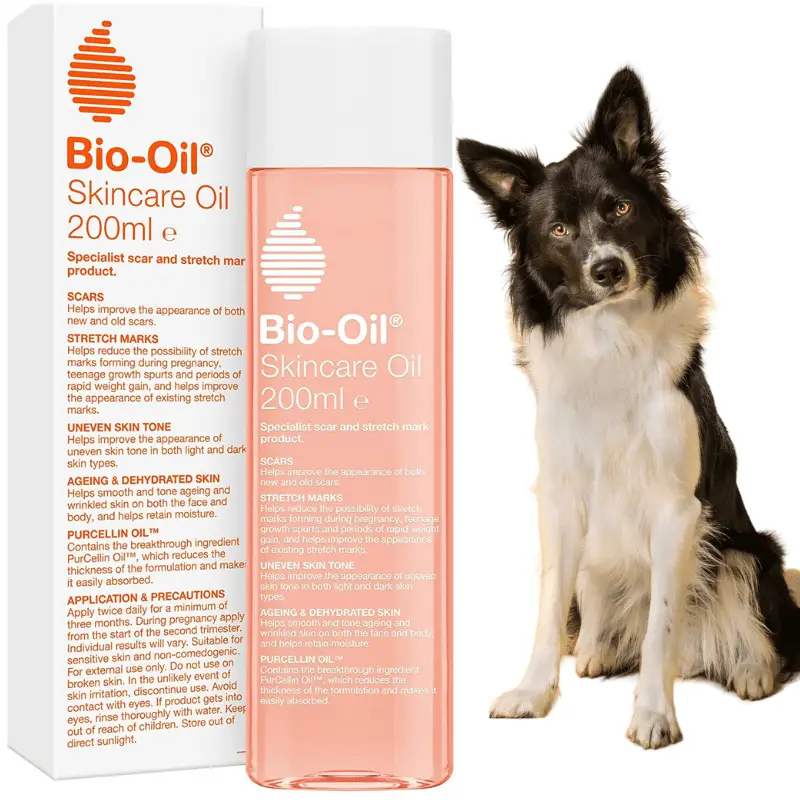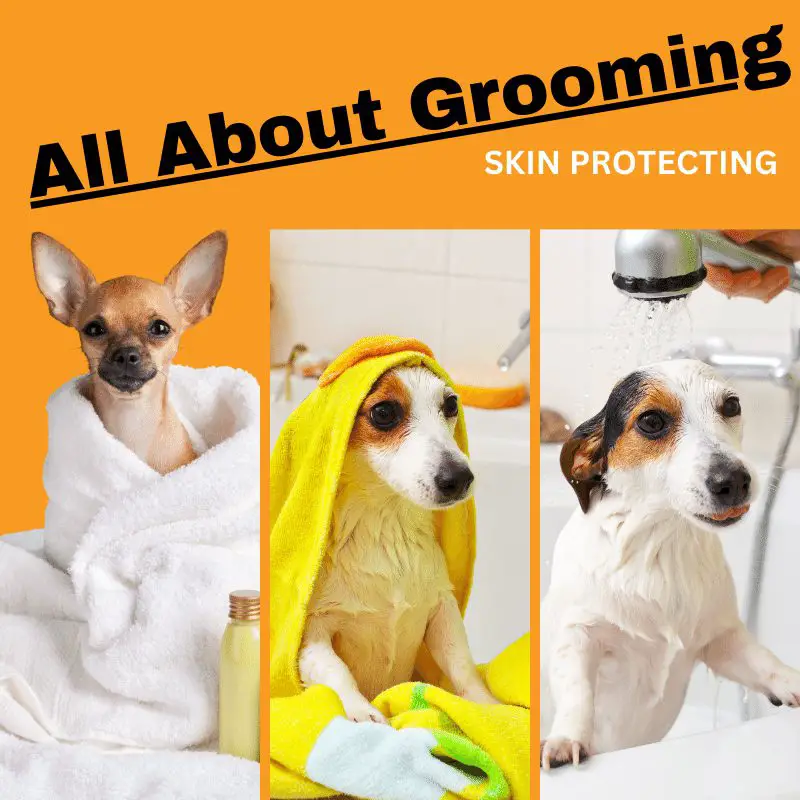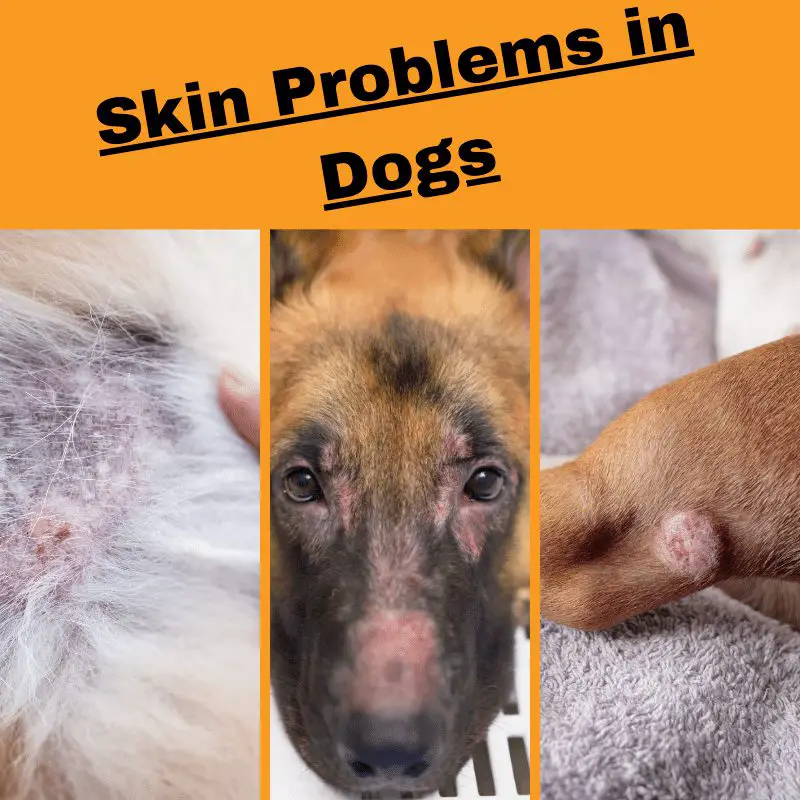There are many potential causes of itchy skin in dogs, from allergies and parasites to infections. As a result, it can be challenging to identify the root cause of the problem. However, you can do a few things to help relieve your dog’s itching.
There are many ways to relieve the itchiness of your dog. You can use a cream or ointment that you buy from a store. It should have ingredients like corticosteroids or colloidal oatmeal, which will help relieve the itching. Alternatively, you can create a homemade remedy containing coconut oil, shea butter, tea tree oil, and apple cider vinegar.
These ingredients can help to soothe irritated skin and provide relief from itchiness. However, it is better to understand the reason behind the itching.
Relieve Itching In Dogs
- Burt’s Bees for Dogs Natural Itch Soothing Spray with Honeysuckle is 100% safe and soothes whilst healing the sores (Favourite)
- Dogslife Itchy Dog Spray To Soothe Itching, Stop Scratching & Support Healing (Average)
- PETUCHI Itchy Skin Relief for Dogs (Average)
- Colloidal Silver Antiseptic Spray All-in-1 Treatment (Cheapest)
- Dog Co Anti-Itch Dog Spray (Most Expensive)
Antiseptic Cream Made Specifically For Dogs
I am introducing an antiseptic cream alternative specially formulated for dogs that can be safely used for extended periods. Unlike other dog creams, this cream has a pleasant scent. I now keep a jar of this cream in my cabinet for my dogs’ long-term skin care needs.
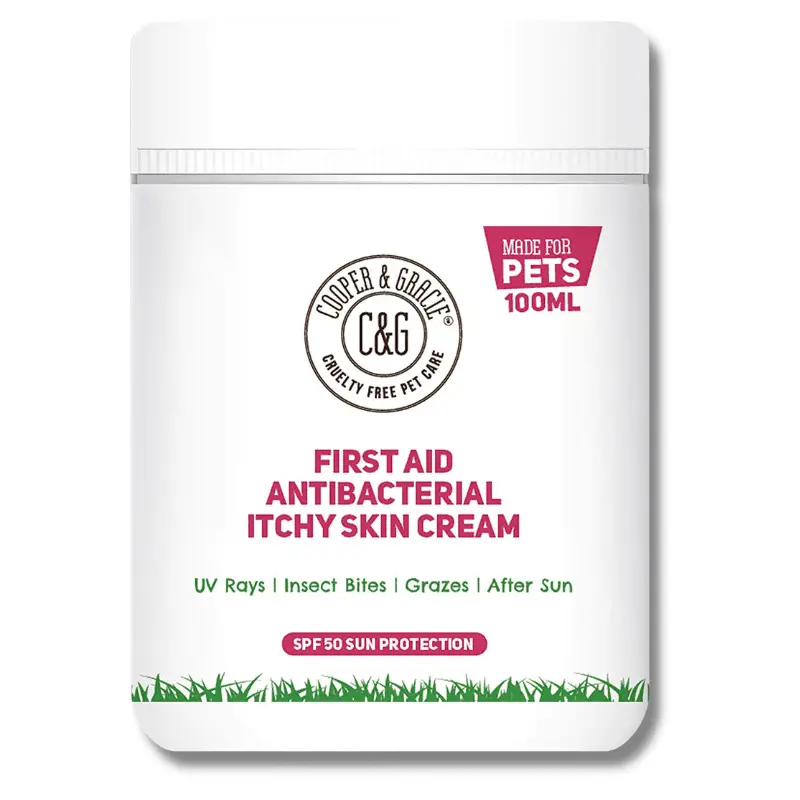
C&G PETS | FIRST-AID ANTIBACTERIAL ITCHY SKIN CREAM WITH SPF 50 | 100% NATURAL ESSENTIAL OIL | MAINTAINS CRACKED ITCHY SKIN | LICK-SAFE NON-TOXIC NON-IRRITANT |HIGHLY ABSORBENT SUN CREAM FOR DOGS 100ML.
Homemade Dog Anti-Itch Remedy
- Coconut Oil – Four tablespoons
- Shea Butter – Two tablespoons
- Tea Tree Oil – Three drops
- Apple Cider Vinger – Two drops
Store in a dry place and out of sunlight. If the skin is broken, do not use it.
The four ingredients above contain an anti-inflammatory, antibacterial, antifungal and humectant, which keeps the skin from drying out and retains the dog’s moisture.
Why Is My Dog Itching So Much?
There are a few reasons why, which I have listed below. Let’s Identify the root cause to avoid future flare-ups and continued discomfort for your dog.
Allergies/Intollernace
Dogs are getting affected by allergies more and more often because they are constantly being exposed to allergens. Exposure to allergens can severely affect a dog’s immune system and health, which causes itchiness in dog.
When the immune system deals with allergies every day, it becomes tired and overworked, leading the body to neglect the skin and coat of a dog. Toxins are also being pushed out internally through the skin, causing the skin issues such as itching.
Hyperpigmentation
Dogs that suffer from allergies also have hyperpigmentation, usually found on their bellies, groin and legs.
Dark colouration, which can be a little rough to touch, is caused by allergies and may go on its own when the allergies are under control.
Dog Shampoo
The shampoo is one of the most commonly used products to clean a dog, but what happens when your dog is allergic to shampoo? A dog allergic to shampoo symptoms includes itchiness, redness, irritation and hair loss.
If your dog starts showing these symptoms straight after bathing, you should switch to a hypoallergenic or oatmeal-based shampoo.
It would be best if you also avoided any shampoos that contain fragrances, dyes, or other harsh chemicals.
If your dog’s allergies are severe, you may need to consult with a veterinarian for additional treatment options. In the meantime, keep your dog comfortable by using only the mildest and most gentle shampoos and bath as little as often until the itchiness has stopped.
Recommended Read: Can I Use Aveeno Lotion On My Dog?
Dog Food Ingredients
Dogs can be allergic to many ingredients in their food, including grains, proteins, chemicals and preservatives.
One of the most common allergies that dogs suffer from is wheat allergies. Wheat is not a natural food source for dogs and certainly not in the massive quantities sometimes found in their food.
If your dog is scratching more than usual, change their food or start a plain homemade diet to rule out the possible culprits.
Follow the below homemade dog food ratio. Variety over two weeks will ensure that a dog gets all of its vitamins and minerals.
- 50% cooked meat/fish (40 – 45% Lean meat & 5-10% organ meat)
- 25% cooked white rice, brown rice, sweet potato or oatmeal/porridge
- 25% steamed or boiled vegetables or fruit (mix of 2/3 different types, more veg than fruit)
Low-Quality Dog Food
When food is of poor quality, a dog’s immune system does not work well, leading to many illnesses like cancer or organ failure. Many skin issues are primarily due to the immune system working too hard.
The immune system even struggles at the simplest of tasks like fighting infection when food quality is poor.
When a dog’s food is of low quality, the immune system won’t get all the vitamins and minerals needed for optimum health, so the dog’s body will have to compensate, and one of those compensations is the dog’s skin.
You may have noticed that even the cheapest dog food brands have the best advertising campaign on the front of the packaging.
Check the back of your dog food label and look for nasty ingredients like bone meal. Bone meal is crushed up bones, and most dog foods will have this in if it’s of poor quality. You need to look for listed ingredients like pure meat, fresh meat, and added Botanicals.
Bone Meal: Bones grounded up of any animal to provide low-quality calcium and filler.
Derivatives: Can be any part of any animal, including beak, bones, or feet added. Sometimes it can state the type of animal. However, it will still be low quality and of any part of that specific animal.
Botanicals, Herbs or Plants: These are added health enhancements for your dog. If this is listed on the label, it means excellent quality dog food with your dog’s health at the forefront of their company.
Pure Meat: Meat taken from a specific animal. Such as beef, chicken, or duck. The best quality cuts of meat and dog brands with pure or fresh meat labelled on the back are of very high quality.
Never trust the front of your dog food packaging! You must always read the back label to understand what is precisely in it.
Environmental Reasons
Another possible cause of itchy skin is environmental allergies, which can be triggered by pollen, dust mites, mould, scented candles or even certain fabrics.
The causes of stress in dogs are environmental and what they are surrounded by day-to-day.
- Some dogs have a fear of noises. This might make them scared of things like traffic or people clapping their hands.
- Dogs that don’t get to socialise with other dogs and people can get stressed out from being in unfamiliar situations.
- Air fresheners or scented candles can be a stress factor.
All of the above depletes the immune system, making it work harder and compensating for dogs’ areas, such as the skin. One of the main symptoms is itchiness.
Parasites
External foreign parasites will cause itchiness in dogs, such as fleas or ticks. They irritate the skin by crawling around and by blood-sucking. You should check your dog fur for any signs of parasites.
You should always de-flea your dog even if they don’t have fleas. It is more of prevention rather than a cure in many cases.
Once fleas have settled on your dogs, it’s tough to get rid of them. They lay many eggs daily and hibernate in fabrics such as cushions, carpets and clothes.
Excessive Behaviours
Excessive behaviours such as self-licking, chewing or biting can lead to infections and itchy skin in dogs.
Dogs often showcase this type of behaviour when they are bored or stressed.
You should look to keep your dog happy with daily walks, puzzle toys, love, attention and confidence training.
Find your local dog behaviourist for help with excessive behaviours in dogs.
Zinc Deficiency
Zinc is an essential mineral for dogs. A deficiency in zinc can lead to health problems, such as skin problems, hair loss, and dermatitis. This can cause a dog to itch. Zinc Responsive Dermatosis (ZRD) is one of the rarer issues, but you should be aware of it.
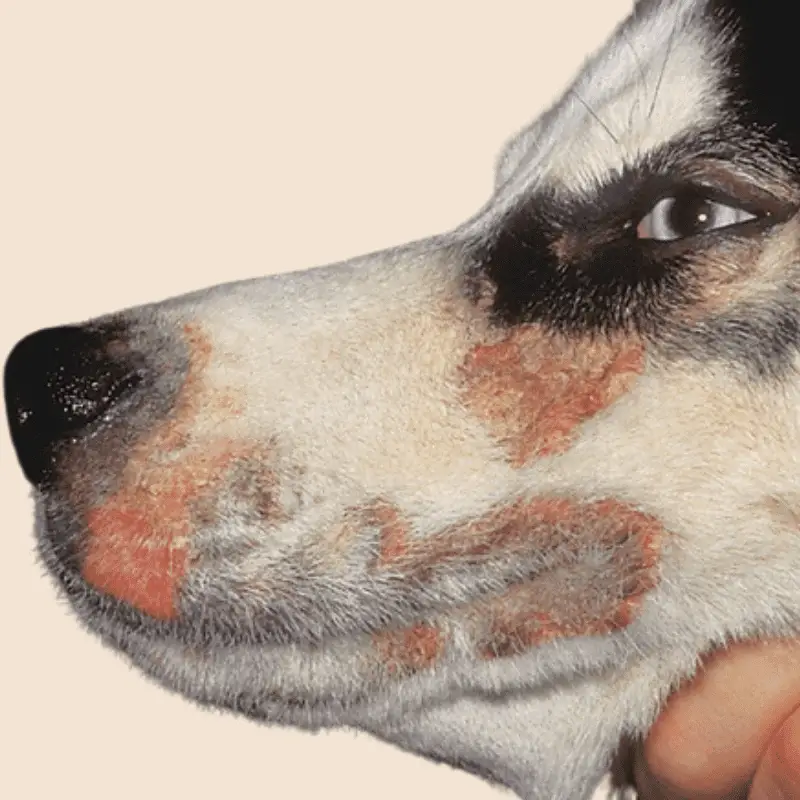
If your dog’s rash looks similar to the image above, you should talk to your veterinarian. ZRD is usually resolved through supplements if they have or are at risk for zinc deficiency.
If you have a Husky or an Alaskan Malamute, zinc deficiency is often seen in these breeds more so than any others.
Location of Symptoms: Dermatologic lesions around the mouth, eyes, elbows, pads
- Reddening of the skin
- Alopecia
- Crusty and thickening of the skin
- Scales
- Sores and weeping
The above can cause infection due to the breakage in the skin and compromised immune system.
What Can You Do To Help Your Itchy Dog?
- Change their food or opt for homemade food instead.
- Change your dog’s bed or wash it with non-biological detergent.
- Complete a dog sensitivity test (Dog intolerance test)
- Consider keeping your dog indoors during high pollen days.
- De flea your dog
- Do not bathe your dog too much, and use a more gentle shampoo, like oatmeal.
- Give your dog hypoallergenic dog food.
- If you have looked at the image for ZRD and it’s similar, please get in touch with your vet asap.
- Please speak to your veterinarian about dust or pollen allergies because they need to be prescribed antihistamines.
- Remove all scented candles or get candles made from safe ingredients
- Speak to a local dog behaviourist for excessive behaviours.
- Try to understand your dog’s behaviour during stressful times to resolve it.
Homemade Food For Dogs With Itchy Skin
Homecook food can offer a dog more quality nutrition than kibble or canned. It will give your dog the best armour to tackle any health issues.

To try to resolve itchy skin through homemade meals is a great way forward. If you make homemade meals for your dog, use the ratio below and the listed safe ingredients. Using variety over two weeks, you can provide for your dog’s nutritional needs.
Stick to the ratio below and add lots of variety to each meal. For instance, one day, you will have turkey; the next will be chicken. For any signs of diarrhoea, don’t use the same ingredient.
Start with ingredients not current in your dog’s food already to rule out allergies.
- 50% cooked meat/fish (40 – 45% Lean meat & 5-10% organ meat)
- 25% cooked white rice, brown rice, sweet potato or oatmeal/porridge
- 25% steamed or boiled vegetables or fruit (mix of 2/3 different types, more veg than fruit)
Fruits
- Apples
- Apricots
- Bananas
- Blackberries
- Blueberries
- Cherries
- Cranberries
- Kiwi
- Mango
- Oranges
- Peaches
- Pears
- Pineapple
- Plums
- Strawberries
- Watermelon
Vegetables
- Aubergine
- Broccoli
- Brussel sprouts
- Carrot
- Cauliflower
- Celery
- Courgette
- Cucumber
- Green beans
- Kale
- lettuce
- Parsnips
- Peas
- Peppers
- Pumpkin
- Spinach
- White and Red Cabbage
Carbs
- Sweet potato
- White Rice
- Brown Rice
- Oatmeal/porridge
- Mashed potato
Read More: Carbohydrates Dog Can and Can’t Eat
Lean Meat/Fish
- Chicken
- Turkey
- Beef
- Duck
- Salmon
Organ Meat
- Chicken liver
- Turkey liver
- Beef liver
- Duck liver
All the above foods should be peeled and washed, either steamed or boiled. Never add any seasoning or oil.
Added Super Boost Extras To Add to Homemade Dog Foods
Egg
Give your dog a nutritional boost by either scrambling, boiling, or poaching an egg. Eggs contain amino acids that help regenerate new skin cells, plus omega 3, vitamin D, and protein. They also have good cholesterol.
Cashews
Perfect for a super boost, cashews are rich in fibre, protein and healthy fats.
Pumpkin Seeds
Rich in antioxidants that can help with fighting illnesses like cancer. Pumpkin seeds are also good for a dog’s heart and help control their blood sugar levels.
Rosemary
Rosemary is a natural repellent for fleas. It also has many health benefits, including improving memory, mood, and digestion.
Sardines
Two of the essential fats that a dog can benefit significantly from are the following:
- Eicosapentaenoic Acid (EPA) an imporant anti-inflammatory fatty acid
- Docosahexaenoic Acid (DHA) is necessary for a dog’s eye health and brain.
You can get these exceptional fats in a single can of sardines in spring water.
You can give them sardines once a week. Sardines will be good for their health, and they can eat them with their regular food.
Avoid These Fruit and Vegetables
- Avacado (High in fat and has persin in, which is a fungicidal toxin)
- Chilli peppers (Causes stomach problems)
- Chives (Extremely Toxic)
- Garlic (Extremely Toxic)
- Grapes (Extremely Toxic)
- Leeks (Extremely Toxic)
- Lemons (A little too acidic for dogs)
- Onions (Extremely Toxic)
- Shallots (Extremely Toxic)
- Tomatoes (A little too acidic for dogs)
MUST-READ: Warning! Allium Family Foods And Dogs (Prevention, Toxicity, Symptoms, Recovery)
Rotating Food
It’s so important to rotate your dog’s food to avoid allergies. If a dog is fed the same food for many years, it can become allergic.
The common foods are beef, chicken, corn, eggs, fish, lamb, soy, turkey, wheat, and yeast.
Due to overexposure to the same food, they become allergic to the ingredient.
Food intolerance mainly affects a dog’s digestive system, resulting in diarrhoea and vomiting.
Yes, it is known to help skin conditions in dogs like hot spots, bites, stings, or itchy, dry skin. Coconut oil can improve damaged skin and reduce allergens.
An oatmeal bath is an excellent way to soothe your dog’s skin and stop the itching. You can give your dog an oatmeal bath to calm your dog’s skin, thus making them feel better.
Last Words
You can relieve itching in dogs using a cream as a temporary measure; however, it is much better to understand why they are itching in the first place to avoid future problems repeating themselves.
There will be a reason why your dog is itching.
Using the above information should give you a good idea of what is causing it and what to do about it.
It’s down to you to figure it out.
Good Luck!

